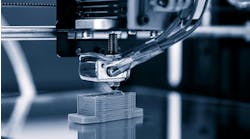GE Keeps Its Checkbook Handy After All-in Bet on 3-D Printing
General Electric Co. (IW 500/6) shook up the 3-D printer market last year by laying down more than $1 billion on two acquisitions. Turns out that may be just the beginning.
The manufacturing giant is weighing additional purchases to expand the fast-growing business, said David Joyce, GE’s vice chair in charge of 3-D printing. The burgeoning technology is becoming a new product line as well as a central component of GE’s effort to modernize its manufacturing operations, boost productivity and reshape how everything from locomotives to medical scanners to jet engines are made.
In that process, GE is racing to beat out competitors such as Siemens AG and United Technologies Corp., which also are integrating advanced printers into their operations. The moves come as manufacturing is thrust into the spotlight amid the rise of President Donald Trump, who has pledged to revitalize the sector and reverse decades of job losses. While 3-D technology could help bring back factories, it’s unlikely to do the same for factory workers.
The ability to print complex parts is “one of the most disruptive innovations I’ve seen in the manufacturing space in my 37 years here,” Joyce said in an interview in his Cincinnati-area office. As chief executive officer of GE Aviation, he’s helping lead adoption of 3-D technology within the company by incorporating printed parts into jet engines. “Manufacturing is going through a renaissance,” he said.
Industrial 3-D printing, also known as additive manufacturing, uses lasers and other technology to fuse ultra-thin layers of material such as metal powder or polymers, building parts from the bottom up. In a few hours, a machine can construct complex components that otherwise would be difficult or impossible to make. While the process has been used to build quick prototypes, integration into full-scale manufacturing has been limited by material and cost issues.
GE will expand its 3-D printing business through a combination of acquisitions and organic growth, Joyce said without naming potential targets. Several additive manufacturers have gained recently on increased investor interest in the technology. Stratasys Ltd. surged 45% this year through Wednesday, while 3D Systems Corp. advanced 15%.
New applications are emerging and GE’s aggressive push into the market may lead to quicker adoption of the machines across the factory sector. The global market for industrial 3-D printers and materials increased 17% last year to $6.06 billion, according to data from Wohlers Associates Inc. The research firm projects the market to balloon to $26.2 billion by 2022.
GE is even more optimistic. The technology could take a piece of the roughly $14 trillion market for traditional manufacturing, said Mohammad Ehteshami, GE’s vice president of additive integration.
“If we do only half a percent, that’s still $70 billion,” he said.
The Boston-based company is in prime position, having spent more than $1 billion late last year to take majority stakes in European printer makers Arcam AB and Concept Laser GmbH.
A Couple of Rebuffs
GE has aggressively sought out deals. Before striking the Concept Laser pact, the company made an offer for Germany’s SLM Solutions Group AG. GE walked away after failing to receive support from SLM investors including billionaire Paul Singer. GE also approached Germany’s EOS GmbH but was rebuffed.
“I said, why should we become part of a customer when there’s a market to develop?” recalled Hans Langer, the founder and CEO of closely held EOS.
GE aims to sell 9,000 3-D printers to outside customers over the next decade in industries such as automotive, medical and aerospace. And by the middle of the next decade, the company expects to wring $3 billion to $5 billion from costs by using the machines in its own manufacturing operations, Joyce said.
GE had its “Aha!” moment in 2011.
After failing eight times to build an intricate part for a new jet turbine, engineers sent the design to a 3-D printing company, Morris Technologies. A few days later, GE had the metal-alloy piece in hand, and Ehteshami rushed to GE’s head of manufacturing.
“I said, ‘Buy ’em, trust me,’” Ehteshami recalled. GE acquired Morris in 2012, and the part -- a fuel nozzle -- is now used in new jet engines.
In Pursuit of Competitive Advantage
The stakes are high as major manufacturers try to reap competitive advantage from new technology. GE’s aviation division is working on a new turboprop engine for which about 35% will be 3-D printed. United Technologies’ Pratt & Whitney division uses printed brackets and other components for a jet engine that competes with one made by GE. At a February shareholder meeting, Siemens CEO Joe Kaeser showed off a 3-D-printed turbine blade that is being tested.
“It’s really a revolution in how we design, produce, buy and digitally connect parts,” said Markus Seibold, the head of additive manufacturing for Siemens Power and Gas, which competes with GE’s power-turbine business.
Printing could also upend the supply chain as equipment makers rely less on third parties for processes like casting and forging. And over time, machinery like 3-D printers and robots could further displace workers; since peaking in 1979, the number of U.S. manufacturing jobs has fallen 37% to about 12.4 million, according to the Bureau of Labor Statistics.
Alongside tech giants such as IBM and Amazon, GE has “the deep pockets and they’re taking a lead” in modernizing U.S. manufacturing, said Barclays Plc analyst Scott Davis.
“They could screw it up, but they could get it right,” Davis said. “And if they get it right it could be amazingly valuable.”
By Richard Clough and Oliver Sachgau




